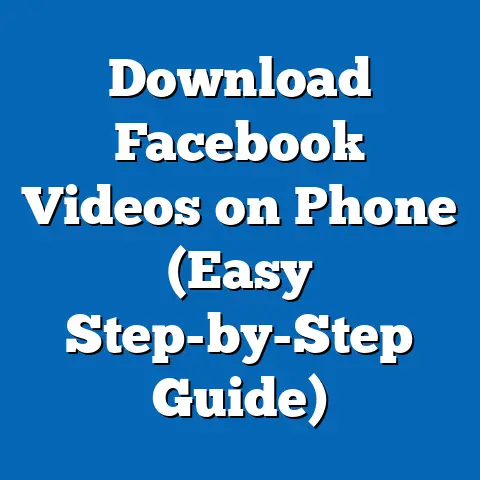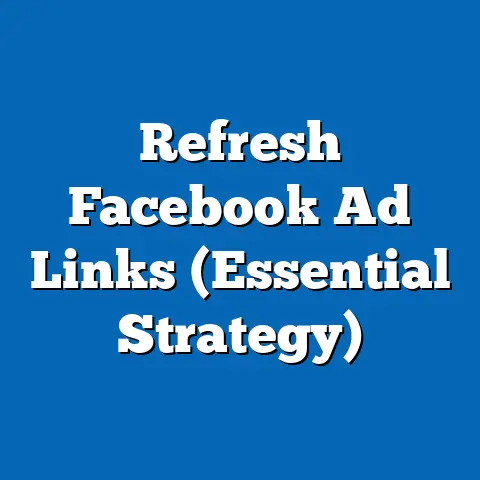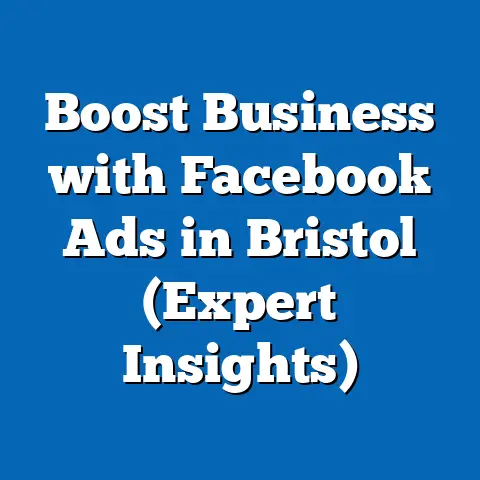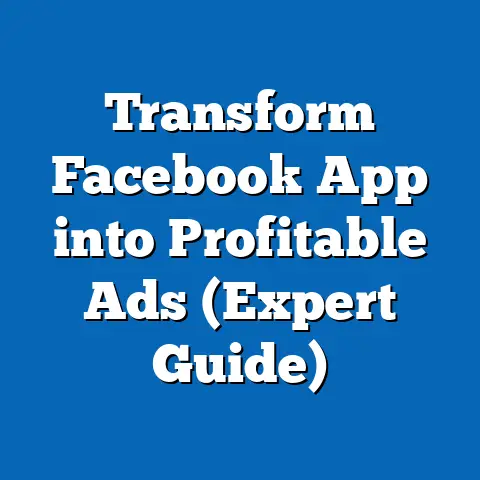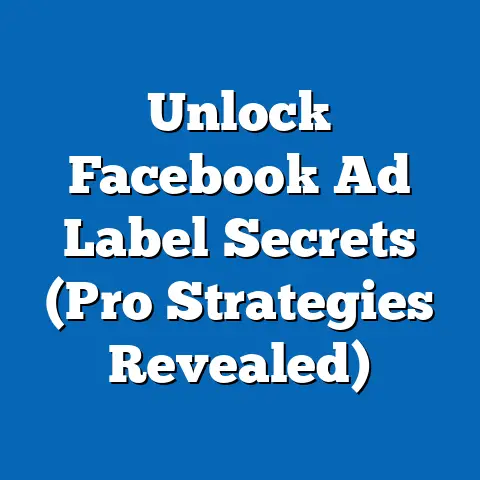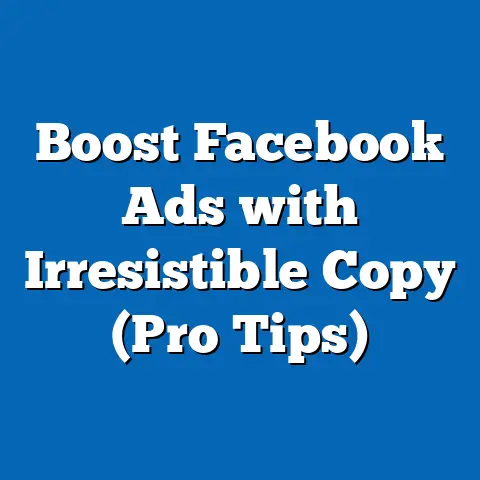Unlock Facebook Message Ads for More Sales (Proven Strategies)
Have you ever felt like your Facebook ads are shouting into a void? Like you’re throwing money at the platform and hoping something sticks? I’ve been there. We all have. But what if I told you there’s a “best-kept secret” in digital marketing that can cut through the noise and deliver personalized, high-converting interactions? That secret is Facebook Message Ads.
In today’s digital landscape, where consumers are bombarded with countless ads daily, personalized communication is no longer a luxury—it’s a necessity. Think about it: we crave connection. We want to feel seen and understood. And Facebook Message Ads, when used strategically, can bridge that gap, fostering genuine engagement and driving significant sales growth.
Facebook, with its billions of active users, remains a powerhouse for advertisers. But simply throwing up a standard ad and hoping for the best isn’t enough anymore. We need to be smarter, more targeted, and more personal. That’s where Message Ads come in. They offer a unique way to connect with potential customers on a one-to-one basis, offering a personalized experience that can significantly boost conversions.
This isn’t just hype. I’ve seen firsthand how Message Ads can transform a campaign. I remember working with a local e-commerce store struggling to generate leads. Their standard Facebook ads were getting clicks, but not sales. We decided to experiment with Click-to-Messenger ads, offering a personalized discount code to anyone who messaged their page. The results were incredible. Not only did their lead generation skyrocket, but their conversion rates doubled. It was a game-changer.
Get ready to discover the power of personalized communication and transform your Facebook advertising strategy with Message Ads. Let’s dive in!
Understanding Facebook Message Ads
Before we jump into the strategies, let’s make sure we’re all on the same page about what Facebook Message Ads actually are. They’re more than just ads that appear in someone’s Messenger inbox. They’re a gateway to personalized conversations and direct engagement with your target audience.
What Are Facebook Message Ads?
Facebook Message Ads are a unique ad format that allows you to initiate conversations with potential customers directly within the Messenger app. Unlike traditional ads that redirect users to a landing page or website, Message Ads encourage immediate interaction. Think of them as a virtual salesperson waiting to answer questions, provide information, and guide users towards a purchase.
These ads typically appear in a user’s Messenger inbox alongside their regular conversations. When a user clicks on a Message Ad, they’re taken directly to a Messenger conversation with your business. From there, you can engage them with personalized messages, answer their questions, and ultimately, drive them towards a sale.
The beauty of Message Ads lies in their ability to foster a sense of connection and trust. By engaging in a real-time conversation, you can build rapport with potential customers, understand their needs, and tailor your messaging accordingly. This level of personalization is simply not possible with traditional ad formats.
Types of Message Ads
Facebook offers several different types of Message Ads, each with its own unique features and benefits. Understanding these different types is crucial for choosing the right format for your specific goals and objectives.
-
Click-to-Messenger Ads: These ads appear in the Facebook News Feed, Instagram Feed, and other placements on the Facebook network. When a user clicks on the ad, they’re taken directly to a Messenger conversation with your business. This is a great option for driving traffic to your Messenger channel and generating leads. I’ve found these particularly effective when offering a valuable incentive, like a discount code or free consultation, in exchange for starting a conversation.
-
Sponsored Messages: These ads are sent directly to people who have already interacted with your business on Messenger. This is a powerful way to re-engage existing customers, promote new products or services, and drive repeat sales. Imagine sending a personalized message to customers who abandoned their shopping cart, reminding them of the items they left behind and offering a special discount to encourage them to complete their purchase. That’s the power of Sponsored Messages.
-
Lead Generation Ads in Messenger: This format allows you to collect lead information directly within the Messenger conversation. You can ask users for their name, email address, phone number, and other relevant information, all without them ever having to leave the Messenger app. This is a great option for building your email list and generating qualified leads for your sales team.
-
Automated Ads in Messenger: These are a newer type of ad that leverages AI to create personalized ad experiences within Messenger. Facebook uses machine learning to optimize the ad copy and creative based on the user’s behavior and preferences. This can be a good option for businesses that want to automate their ad creation process and improve ad performance.
Click-to-Messenger Ads: These ads appear in the Facebook News Feed, Instagram Feed, and other placements on the Facebook network. When a user clicks on the ad, they’re taken directly to a Messenger conversation with your business. This is a great option for driving traffic to your Messenger channel and generating leads. I’ve found these particularly effective when offering a valuable incentive, like a discount code or free consultation, in exchange for starting a conversation.
Sponsored Messages: These ads are sent directly to people who have already interacted with your business on Messenger. This is a powerful way to re-engage existing customers, promote new products or services, and drive repeat sales. Imagine sending a personalized message to customers who abandoned their shopping cart, reminding them of the items they left behind and offering a special discount to encourage them to complete their purchase. That’s the power of Sponsored Messages.
Lead Generation Ads in Messenger: This format allows you to collect lead information directly within the Messenger conversation. You can ask users for their name, email address, phone number, and other relevant information, all without them ever having to leave the Messenger app. This is a great option for building your email list and generating qualified leads for your sales team.
Automated Ads in Messenger: These are a newer type of ad that leverages AI to create personalized ad experiences within Messenger. Facebook uses machine learning to optimize the ad copy and creative based on the user’s behavior and preferences. This can be a good option for businesses that want to automate their ad creation process and improve ad performance.
Benefits of Using Message Ads
The benefits of using Message Ads are numerous, but here are some of the most significant advantages:
-
Direct Engagement: Message Ads allow you to engage with potential customers on a one-to-one basis, fostering a sense of connection and trust. This direct engagement can lead to higher conversion rates and increased customer loyalty.
-
Higher Conversion Rates: Because Message Ads allow for personalized conversations and immediate answers to questions, they often result in higher conversion rates compared to traditional ad formats. People are more likely to make a purchase when they feel like they’re being heard and understood.
-
Personalized Experiences: Message Ads enable you to create personalized experiences for each user, tailoring your messaging to their specific needs and interests. This level of personalization can significantly improve ad performance and customer satisfaction.
-
Lead Qualification: By engaging in conversations with potential customers, you can quickly qualify leads and identify those who are most likely to make a purchase. This allows you to focus your sales efforts on the most promising prospects.
-
Cost-Effective: In many cases, Message Ads can be more cost-effective than traditional ad formats, especially when you factor in the higher conversion rates and increased customer lifetime value.
-
Data Collection: Messenger conversations provide valuable data about your customers’ needs and preferences. This data can be used to improve your targeting, messaging, and overall marketing strategy.
Direct Engagement: Message Ads allow you to engage with potential customers on a one-to-one basis, fostering a sense of connection and trust. This direct engagement can lead to higher conversion rates and increased customer loyalty.
Higher Conversion Rates: Because Message Ads allow for personalized conversations and immediate answers to questions, they often result in higher conversion rates compared to traditional ad formats. People are more likely to make a purchase when they feel like they’re being heard and understood.
Personalized Experiences: Message Ads enable you to create personalized experiences for each user, tailoring your messaging to their specific needs and interests. This level of personalization can significantly improve ad performance and customer satisfaction.
Lead Qualification: By engaging in conversations with potential customers, you can quickly qualify leads and identify those who are most likely to make a purchase. This allows you to focus your sales efforts on the most promising prospects.
Cost-Effective: In many cases, Message Ads can be more cost-effective than traditional ad formats, especially when you factor in the higher conversion rates and increased customer lifetime value.
Data Collection: Messenger conversations provide valuable data about your customers’ needs and preferences. This data can be used to improve your targeting, messaging, and overall marketing strategy.
Takeaway: Facebook Message Ads offer a powerful way to connect with potential customers on a personal level, driving engagement, conversions, and customer loyalty. Understanding the different types of Message Ads and their benefits is crucial for creating a successful campaign. The next step is to develop proven strategies to maximize their effectiveness.
Proven Strategies for Effective Message Ads
Now that we’ve covered the basics of Facebook Message Ads, let’s dive into some proven strategies for maximizing their effectiveness. These strategies are based on my own experience, as well as insights from other successful marketers.
Crafting the Perfect Message
The message you send in your Message Ad is crucial for capturing attention and driving engagement. It’s your first impression, and you need to make it count.
-
Keep it Concise and Engaging: People are busy, and they don’t want to read long, rambling messages. Keep your message concise, clear, and engaging. Get straight to the point and highlight the benefits of engaging with your business. I often use a hook that immediately grabs attention, like a question or a surprising statistic.
-
Personalize Your Message: Use the user’s name and refer to their interests or past interactions with your business. This shows that you’re paying attention and that you care about their individual needs. Facebook allows you to dynamically insert the user’s name into your message, which makes personalization easy.
-
Offer Value: Give users a reason to engage with your business. Offer a discount, a free consultation, a valuable piece of content, or something else that they’ll find appealing. The value you offer should be relevant to their interests and needs.
-
Use a Clear Call-to-Action (CTA): Tell users exactly what you want them to do. Do you want them to ask a question? Claim a discount? Schedule a consultation? Make it clear in your CTA. Examples include: “Learn More,” “Get Your Discount,” “Book a Free Call,” or “Shop Now.” Make sure your CTA aligns with the overall goal of your campaign.
-
Write Like a Human: Avoid sounding like a robot or a generic marketing message. Write in a conversational tone that feels natural and authentic. Imagine you’re talking to a friend or colleague.
-
Use Emojis (Sparingly): Emojis can add personality and visual appeal to your message, but don’t overdo it. Use them sparingly and strategically to enhance your message, not distract from it.
-
Proofread Carefully: Before you launch your Message Ad, proofread your message carefully for any typos or grammatical errors. A poorly written message can damage your credibility and reduce engagement.
Keep it Concise and Engaging: People are busy, and they don’t want to read long, rambling messages. Keep your message concise, clear, and engaging. Get straight to the point and highlight the benefits of engaging with your business. I often use a hook that immediately grabs attention, like a question or a surprising statistic.
Personalize Your Message: Use the user’s name and refer to their interests or past interactions with your business. This shows that you’re paying attention and that you care about their individual needs. Facebook allows you to dynamically insert the user’s name into your message, which makes personalization easy.
Offer Value: Give users a reason to engage with your business. Offer a discount, a free consultation, a valuable piece of content, or something else that they’ll find appealing. The value you offer should be relevant to their interests and needs.
Use a Clear Call-to-Action (CTA): Tell users exactly what you want them to do. Do you want them to ask a question? Claim a discount? Schedule a consultation? Make it clear in your CTA. Examples include: “Learn More,” “Get Your Discount,” “Book a Free Call,” or “Shop Now.” Make sure your CTA aligns with the overall goal of your campaign.
Write Like a Human: Avoid sounding like a robot or a generic marketing message. Write in a conversational tone that feels natural and authentic. Imagine you’re talking to a friend or colleague.
Use Emojis (Sparingly): Emojis can add personality and visual appeal to your message, but don’t overdo it. Use them sparingly and strategically to enhance your message, not distract from it.
Proofread Carefully: Before you launch your Message Ad, proofread your message carefully for any typos or grammatical errors. A poorly written message can damage your credibility and reduce engagement.
I once worked with a client who was struggling to get engagement with their Message Ads. Their messages were generic and impersonal, and they didn’t offer any real value. We rewrote their messages to be more concise, personalized, and value-driven, and the results were dramatic. Their engagement rates tripled, and their conversion rates doubled. The key was to focus on creating messages that resonated with the target audience and offered them a compelling reason to engage.
Targeting the Right Audience
No matter how compelling your message is, it won’t be effective if you’re not targeting the right audience. Facebook’s targeting capabilities are incredibly powerful, and you need to leverage them to ensure that your Message Ads are reaching the people who are most likely to be interested in your products or services.
-
Define Your Target Audience: Before you start creating your Message Ad, take the time to clearly define your target audience. Who are you trying to reach? What are their demographics, interests, and behaviors? The more specific you can be, the better.
-
Leverage Facebook’s Targeting Options: Facebook offers a wide range of targeting options, including:
- Demographics: Target users based on their age, gender, location, education, and other demographic factors.
- Interests: Target users based on their interests, hobbies, and passions.
- Behaviors: Target users based on their online behavior, such as their purchase history, website visits, and engagement with other Facebook pages.
- Custom Audiences: Upload a list of your existing customers or website visitors to create a custom audience. This is a great way to re-engage people who have already interacted with your business.
- Lookalike Audiences: Create a lookalike audience based on your existing customers or website visitors. This allows you to reach new people who are similar to your best customers.
-
Experiment with Different Targeting Options: Don’t be afraid to experiment with different targeting options to see what works best for your business. Try combining different targeting options to create highly targeted audiences.
-
Use Audience Insights: Facebook’s Audience Insights tool provides valuable data about your target audience, including their demographics, interests, and behaviors. Use this tool to gain a deeper understanding of your audience and refine your targeting.
-
Exclude Irrelevant Audiences: Just as important as targeting the right audience is excluding irrelevant audiences. For example, if you’re selling products for women, you might want to exclude men from your targeting.
Define Your Target Audience: Before you start creating your Message Ad, take the time to clearly define your target audience. Who are you trying to reach? What are their demographics, interests, and behaviors? The more specific you can be, the better.
Leverage Facebook’s Targeting Options: Facebook offers a wide range of targeting options, including:
- Demographics: Target users based on their age, gender, location, education, and other demographic factors.
- Interests: Target users based on their interests, hobbies, and passions.
- Behaviors: Target users based on their online behavior, such as their purchase history, website visits, and engagement with other Facebook pages.
- Custom Audiences: Upload a list of your existing customers or website visitors to create a custom audience. This is a great way to re-engage people who have already interacted with your business.
- Lookalike Audiences: Create a lookalike audience based on your existing customers or website visitors. This allows you to reach new people who are similar to your best customers.
Experiment with Different Targeting Options: Don’t be afraid to experiment with different targeting options to see what works best for your business. Try combining different targeting options to create highly targeted audiences.
Use Audience Insights: Facebook’s Audience Insights tool provides valuable data about your target audience, including their demographics, interests, and behaviors. Use this tool to gain a deeper understanding of your audience and refine your targeting.
Exclude Irrelevant Audiences: Just as important as targeting the right audience is excluding irrelevant audiences. For example, if you’re selling products for women, you might want to exclude men from your targeting.
I remember working with a fashion retailer who was targeting a broad audience with their Message Ads. They were getting a lot of impressions, but their conversion rates were low. We narrowed their targeting to focus on women aged 25-45 who were interested in fashion and shopping, and their conversion rates skyrocketed. The key was to focus on reaching the people who were most likely to be interested in their products.
Utilizing Chatbots for Automation
Chatbots can be a powerful tool for automating your Messenger conversations and enhancing user interaction. They can handle basic inquiries, qualify leads, and even guide users through the purchase process.
-
Choose the Right Chatbot Platform: There are many different chatbot platforms available, each with its own features and pricing. Choose a platform that meets your specific needs and budget. Some popular options include ManyChat, Chatfuel, and MobileMonkey.
-
Design a Conversational Flow: Before you start building your chatbot, take the time to design a conversational flow. Map out the different questions users might ask and the responses your chatbot will provide.
-
Personalize the Experience: Use the user’s name and refer to their interests or past interactions with your business. This will make the chatbot experience feel more personal and engaging.
-
Offer Value: Provide users with valuable information, discounts, or other incentives to keep them engaged with the chatbot.
-
Human Takeover: Make sure there’s always a way for users to connect with a human agent if they need help or have a question that the chatbot can’t answer.
-
Test and Optimize: Continuously test and optimize your chatbot to improve its performance. Monitor user feedback and make adjustments to your conversational flow as needed.
Choose the Right Chatbot Platform: There are many different chatbot platforms available, each with its own features and pricing. Choose a platform that meets your specific needs and budget. Some popular options include ManyChat, Chatfuel, and MobileMonkey.
Design a Conversational Flow: Before you start building your chatbot, take the time to design a conversational flow. Map out the different questions users might ask and the responses your chatbot will provide.
Personalize the Experience: Use the user’s name and refer to their interests or past interactions with your business. This will make the chatbot experience feel more personal and engaging.
Offer Value: Provide users with valuable information, discounts, or other incentives to keep them engaged with the chatbot.
Human Takeover: Make sure there’s always a way for users to connect with a human agent if they need help or have a question that the chatbot can’t answer.
Test and Optimize: Continuously test and optimize your chatbot to improve its performance. Monitor user feedback and make adjustments to your conversational flow as needed.
I’ve seen chatbots transform the way businesses handle customer service and lead generation. One of my clients, a real estate agency, implemented a chatbot that could answer basic questions about their listings, schedule showings, and even qualify leads. The chatbot freed up their agents to focus on more complex tasks, and it significantly improved their lead generation efforts.
Timing and Frequency
The timing and frequency of your Message Ads can have a significant impact on their performance. You need to reach your target audience when they’re most likely to be receptive to your message, and you need to avoid bombarding them with too many ads.
-
Identify Peak Engagement Times: Use Facebook’s Insights tool to identify the times of day and days of the week when your target audience is most active on Facebook and Messenger.
-
Schedule Your Ads Accordingly: Schedule your Message Ads to run during peak engagement times.
-
Use Frequency Capping: Facebook allows you to set a frequency cap, which limits the number of times a user will see your ad. This helps to prevent ad fatigue and ensure that your ads are not becoming annoying.
-
Monitor Ad Performance: Continuously monitor the performance of your Message Ads and adjust your timing and frequency as needed.
-
Consider Time Zones: If you’re targeting a global audience, consider the different time zones and schedule your ads accordingly.
Identify Peak Engagement Times: Use Facebook’s Insights tool to identify the times of day and days of the week when your target audience is most active on Facebook and Messenger.
Schedule Your Ads Accordingly: Schedule your Message Ads to run during peak engagement times.
Use Frequency Capping: Facebook allows you to set a frequency cap, which limits the number of times a user will see your ad. This helps to prevent ad fatigue and ensure that your ads are not becoming annoying.
Monitor Ad Performance: Continuously monitor the performance of your Message Ads and adjust your timing and frequency as needed.
Consider Time Zones: If you’re targeting a global audience, consider the different time zones and schedule your ads accordingly.
I once worked with a restaurant who was running Message Ads throughout the day. We analyzed their data and discovered that their peak engagement times were between 5 PM and 8 PM, when people were thinking about dinner. We adjusted their ad schedule to focus on those peak times, and their engagement rates increased significantly.
Testing and Optimization
Testing and optimization are essential for maximizing the performance of your Message Ads. You need to continuously test different aspects of your ads, such as your copy, visuals, and targeting, and make data-driven adjustments to improve your results.
-
A/B Testing: A/B testing involves creating two versions of your ad, with one slight variation, and then running them simultaneously to see which one performs better. For example, you could A/B test different headlines, images, or CTAs.
-
Test Different Targeting Options: Experiment with different targeting options to see which ones generate the best results.
-
Track Key Metrics: Track key metrics, such as impressions, clicks, engagement, and conversions, to measure the performance of your ads.
-
Use Facebook Analytics: Facebook Analytics provides valuable data about your website traffic and user behavior. Use this data to gain a deeper understanding of your audience and optimize your ads accordingly.
-
Make Data-Driven Adjustments: Based on your testing and analysis, make data-driven adjustments to your ads to improve their performance.
-
Don’t Be Afraid to Experiment: Don’t be afraid to experiment with new ideas and approaches. The key to success is to continuously test and optimize your ads to find what works best for your business.
A/B Testing: A/B testing involves creating two versions of your ad, with one slight variation, and then running them simultaneously to see which one performs better. For example, you could A/B test different headlines, images, or CTAs.
Test Different Targeting Options: Experiment with different targeting options to see which ones generate the best results.
Track Key Metrics: Track key metrics, such as impressions, clicks, engagement, and conversions, to measure the performance of your ads.
Use Facebook Analytics: Facebook Analytics provides valuable data about your website traffic and user behavior. Use this data to gain a deeper understanding of your audience and optimize your ads accordingly.
Make Data-Driven Adjustments: Based on your testing and analysis, make data-driven adjustments to your ads to improve their performance.
Don’t Be Afraid to Experiment: Don’t be afraid to experiment with new ideas and approaches. The key to success is to continuously test and optimize your ads to find what works best for your business.
I always tell my clients that Facebook advertising is not a “set it and forget it” strategy. It requires continuous monitoring, testing, and optimization. The more you experiment and learn, the better your results will be.
Takeaway: By crafting compelling messages, targeting the right audience, utilizing chatbots for automation, optimizing your timing and frequency, and continuously testing and optimizing your ads, you can unlock the full potential of Facebook Message Ads and drive significant results for your business. Now, let’s look at some real-world examples to see these strategies in action.
Case Studies and Success Stories
Let’s take a look at some real-world examples of businesses that have successfully implemented Facebook Message Ads. These case studies will illustrate the strategies we’ve discussed and provide actionable insights that you can apply to your own campaigns.
Case Study 1: E-commerce Store – Personalized Discount Codes
Business: A small e-commerce store selling handmade jewelry.
Challenge: Struggling to generate leads and drive sales with traditional Facebook ads.
Strategy: Implemented Click-to-Messenger ads offering a personalized discount code to anyone who messaged their page.
Execution:
- Created visually appealing ads showcasing their jewelry.
- Wrote compelling ad copy highlighting the uniqueness and craftsmanship of their products.
- Offered a 15% discount code to anyone who messaged their page.
- Used a chatbot to automatically deliver the discount code and answer basic questions about their products.
- Targeted women aged 25-45 who were interested in jewelry and fashion.
Results:
- Lead generation increased by 300%.
- Conversion rates doubled.
- Customer engagement significantly improved.
Lessons Learned:
- Offering a valuable incentive, like a discount code, is a great way to encourage users to engage with your business on Messenger.
- Chatbots can automate the process of delivering incentives and answering basic questions.
- Targeting the right audience is crucial for maximizing the effectiveness of your Message Ads.
Case Study 2: Local Restaurant – Reservations and Special Offers
Business: A local restaurant looking to increase reservations and promote special offers.
Challenge: Difficulty filling tables during off-peak hours.
Strategy: Used Sponsored Messages to target existing customers with personalized offers and reservation reminders.
Execution:
- Segmented their customer list based on past dining preferences.
- Sent Sponsored Messages to customers who had previously ordered a specific dish, offering a discount on that dish.
- Sent reservation reminders to customers who had previously made reservations.
- Targeted customers who lived within a 5-mile radius of the restaurant.
Results:
- Reservations increased by 20% during off-peak hours.
- Customer engagement significantly improved.
- Repeat business increased.
Lessons Learned:
- Sponsored Messages are a powerful way to re-engage existing customers.
- Personalizing offers based on past dining preferences can significantly improve response rates.
- Targeting customers based on location can help to drive local business.
Case Study 3: Fitness Studio – Lead Generation and Class Sign-Ups
Business: A fitness studio looking to generate leads and increase class sign-ups.
Challenge: Difficulty reaching new potential clients in their local area.
Strategy: Implemented Lead Generation Ads in Messenger to collect contact information and offer a free trial class.
Execution:
- Created visually appealing ads showcasing their studio and classes.
- Wrote compelling ad copy highlighting the benefits of their fitness programs.
- Used Lead Generation Ads in Messenger to collect contact information and offer a free trial class.
- Targeted people aged 25-45 who were interested in fitness and health.
Results:
- Lead generation increased by 250%.
- Class sign-ups increased by 150%.
- Cost per lead decreased significantly.
Lessons Learned:
- Lead Generation Ads in Messenger are a great way to collect contact information and generate qualified leads.
- Offering a free trial class is a compelling incentive for potential clients.
- Targeting people who are interested in fitness and health can significantly improve lead generation efforts.
Takeaway: These case studies demonstrate the power of Facebook Message Ads when used strategically. By crafting compelling messages, targeting the right audience, utilizing chatbots for automation, and offering valuable incentives, businesses can achieve significant results. Now, let’s address some common challenges that businesses face when using Message Ads.
Overcoming Common Challenges
While Facebook Message Ads can be incredibly effective, they’re not without their challenges. Let’s discuss some common pitfalls and how to overcome them.
Identifying Potential Pitfalls
-
Low Engagement Rates: If your Message Ads aren’t generating enough engagement, it could be due to a number of factors, such as poorly written copy, irrelevant targeting, or a lack of value.
- Solution: Review your ad copy and make sure it’s concise, engaging, and personalized. Refine your targeting to ensure that you’re reaching the right audience. Offer a valuable incentive to encourage users to engage with your business.
-
High Ad Costs: If your Message Ads are costing too much, it could be due to a competitive bidding environment or poor ad quality.
- Solution: Optimize your ad copy and visuals to improve your ad quality score. Experiment with different bidding strategies to find one that’s cost-effective. Consider using a narrower targeting audience to reduce competition.
-
User Drop-Off: If users are dropping off before completing the desired action, it could be due to a confusing or frustrating chatbot experience.
- Solution: Simplify your chatbot flow and make sure it’s easy for users to navigate. Offer a clear path to connect with a human agent if they need help.
-
Negative Feedback: If you’re receiving negative feedback on your Message Ads, it could be due to irrelevant targeting, annoying ad frequency, or misleading ad copy.
- Solution: Refine your targeting to ensure that you’re reaching the right audience. Reduce your ad frequency to avoid annoying users. Make sure your ad copy is accurate and honest.
Low Engagement Rates: If your Message Ads aren’t generating enough engagement, it could be due to a number of factors, such as poorly written copy, irrelevant targeting, or a lack of value.
- Solution: Review your ad copy and make sure it’s concise, engaging, and personalized. Refine your targeting to ensure that you’re reaching the right audience. Offer a valuable incentive to encourage users to engage with your business.
High Ad Costs: If your Message Ads are costing too much, it could be due to a competitive bidding environment or poor ad quality.
- Solution: Optimize your ad copy and visuals to improve your ad quality score. Experiment with different bidding strategies to find one that’s cost-effective. Consider using a narrower targeting audience to reduce competition.
User Drop-Off: If users are dropping off before completing the desired action, it could be due to a confusing or frustrating chatbot experience.
- Solution: Simplify your chatbot flow and make sure it’s easy for users to navigate. Offer a clear path to connect with a human agent if they need help.
Negative Feedback: If you’re receiving negative feedback on your Message Ads, it could be due to irrelevant targeting, annoying ad frequency, or misleading ad copy.
- Solution: Refine your targeting to ensure that you’re reaching the right audience. Reduce your ad frequency to avoid annoying users. Make sure your ad copy is accurate and honest.
I’ve seen businesses struggle with all of these challenges, but with a little bit of troubleshooting and optimization, they’ve been able to overcome them and achieve success with Message Ads. The key is to be patient, persistent, and data-driven.
Maintaining Compliance
It’s crucial to be aware of Facebook’s advertising policies and best practices for ensuring compliance while running Message Ads. Violating these policies can result in your ads being disapproved or your account being suspended.
-
Ad Content Policies: Familiarize yourself with Facebook’s ad content policies and make sure your ads comply with these policies. This includes policies related to prohibited content, restricted content, and misleading or deceptive claims.
-
Messenger Platform Policies: Be aware of the Messenger Platform policies and make sure your chatbot complies with these policies. This includes policies related to user privacy, data security, and spam.
-
Advertising Standards: Adhere to high advertising standards and avoid making false or misleading claims.
-
Transparency: Be transparent about your business and the purpose of your Message Ads.
-
User Privacy: Respect user privacy and avoid collecting or using personal information without their consent.
Ad Content Policies: Familiarize yourself with Facebook’s ad content policies and make sure your ads comply with these policies. This includes policies related to prohibited content, restricted content, and misleading or deceptive claims.
Messenger Platform Policies: Be aware of the Messenger Platform policies and make sure your chatbot complies with these policies. This includes policies related to user privacy, data security, and spam.
Advertising Standards: Adhere to high advertising standards and avoid making false or misleading claims.
Transparency: Be transparent about your business and the purpose of your Message Ads.
User Privacy: Respect user privacy and avoid collecting or using personal information without their consent.
Facebook’s advertising policies are constantly evolving, so it’s important to stay up-to-date on the latest changes. You can find the latest policies on Facebook’s Business Help Center.
Takeaway: By being aware of these common challenges and following Facebook’s advertising policies, you can avoid potential pitfalls and ensure that your Message Ads are successful and compliant. Now, let’s wrap things up with a final conclusion.
Recap of Key Points
- Facebook Message Ads offer a powerful way to connect with potential customers on a personal level, driving engagement, conversions, and customer loyalty.
- Crafting compelling messages, targeting the right audience, utilizing chatbots for automation, optimizing your timing and frequency, and continuously testing and optimizing your ads are essential for success.
- Real-world case studies demonstrate the power of Message Ads when used strategically.
- Being aware of common challenges and following Facebook’s advertising policies can help you avoid potential pitfalls and ensure that your Message Ads are successful and compliant.
Call to Action
Now it’s time to take action! I encourage you to implement the strategies outlined in this article and explore the untapped potential of Facebook Message Ads in your marketing efforts.
- Start by creating a simple Click-to-Messenger ad offering a valuable incentive to your target audience.
- Experiment with different targeting options to see what works best for your business.
- Consider using a chatbot to automate your Messenger conversations and enhance user interaction.
- Continuously monitor the performance of your ads and make data-driven adjustments to improve your results.
Don’t be afraid to experiment and try new things. The key to success is to be patient, persistent, and data-driven.
Final Thoughts
Facebook Message Ads are a powerful tool that can help you achieve your marketing goals. They offer a unique way to connect with potential customers on a personal level, build relationships, and drive sales.
In today’s competitive digital landscape, it’s more important than ever to stand out from the crowd and offer a personalized experience to your customers. Facebook Message Ads can help you do just that.
So, embrace this “best-kept secret” and unlock the full potential of Facebook Message Ads for your business growth. I’m confident that you’ll be amazed by the results.
I’ve personally seen the transformative power of Message Ads, and I’m excited to see what you can achieve with them. Good luck, and happy advertising!

